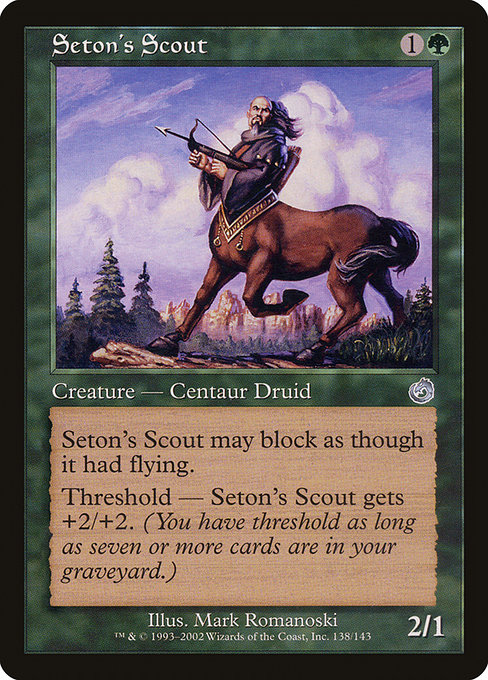
Image courtesy of Scryfall.com
Embeddings in Action: Grouping Green Thresholders Without Losing the Fun
When we talk about clustering MTG cards with embeddings, we’re really talking about teaching a computer to see the story under the text—the way a card’s mana cost, mechanics, and flavor all roar in one cohesive design. The goal isn’t to replace human intuition but to augment it: to surface cards that often show up together in decks, or that share a common strategic arc, even when their names belong to different corners of the multiverse. 🧙🔥💎 In this exploration, we’ll anchor our discussion with a classic green creature from the Torment set—Seton’s Scout—so you can feel how a single card can illuminate a broader clustering narrative. ⚔️
Meet Seton’s Scout
- Name: Seton’s Scout
- Set: Torment (TOR), 2002
- Color: Green
- Mana cost: {1}{G}
- Type: Creature — Centaur Druid Scout Archer
- Power/Toughness: 2/1
- Rarity: Uncommon
- Oracle text: Reach (This creature can block creatures with flying.)
Threshold — This creature gets +2/+2 as long as seven or more cards are in your graveyard. - Artist: Mark Romanoski
For a two-mana 2/1 with Reach, Seton’s Scout already plays with a delicious tug-of-war between tempo and late-game upside. When the graveyard starts to accumulate mass—seven cards is the magical line—the Scout becomes a 4/3 flier-blocker that can swing the tide in green-centered strategies. The card lives in a sweet spot for players who love self-mill, graveyard synergy, and green’s historically robust creature suite. And yes, this is a tightly designed piece: a hint of aggression, a dash of defense, and a mechanic that rewards planning, not just luck. 🎨
Why Seton’s Scout Makes a Great Cluster Anchor
Embeddings thrive on both surface features and deeper traits. For MTG cards, that means combining mana cost, color identity, and explicit mechanics with less obvious signals—like common archetypes, card categories, and even rarity curves. Seton’s Scout is a natural anchor for multiple reasons:
- Green's threshold ecosystem: The card locks into the Threshold mechanic, a recurring design thread across many green cards that reward graveyard activity. This makes it a strong exemplar for a cluster of green cards that both mill and leverage the graveyard in meaningful ways. 🧠
- Reach value in a non-flying world: Green creatures with Reach aren’t ubiquitous, but they’re highly relevant for decks that want to stall flyers while developing the board. This adds a distinct signal for clustering “threshold greens with defensive elements.”
- Low early mana curve with late-game payoff: The {1}{G} cost keeps Seton’s Scout accessible in fast starts, while the threshold boost gives a potential mid- to late-game spike. That duality is exactly what embeddings love when linking cards across sets and eras. ⚔️
- Printed in Torment, with timeless appeal: Torment’s era and its distinctive flavor help embeddings capture era-based patterns without losing relevance for modern players who enjoy legacy and commander formats. The card sits comfortably in Commander as well, where threshold helpers and green recursion shine in many decks. 🧙🔥
From a data perspective, combining Seton’s Scout with other green creatures that feature reach, or with threshold-enabled cards from Annex sets or the broader Torment lineage, helps form a cluster that encodes both the color identity and the mid-game ramp-to-combat dynamic. When you visualize embeddings, you’ll see that the “green threshold reach” space naturally gathers a family of cards—even if their individual silhouettes (names and art) are worlds apart. This is where the magic of clustering truly shines: it reveals structural kinship that isn’t obvious from a card-by-card read. 🎲
From Embeddings to Deckbuilding: Practical Takeaways
Here are concrete ways to translate embedding insights into deckbuilding and play patterns, using Seton’s Scout as a compass:
- Anchor for graveyard-friendly greens: If you’re constructing a green deck with a self-mill or graveyard-threshold angle, Seton’s Scout serves as an archetypal example to model around. Look for other green creatures with ways to pressure the board while you fill the graveyard. 🎯
- Balance of tempo and payoff: The Scout is a reminder that you don’t need a gigantic body to wield impact. In clustering terms, small-but-functional cards often cluster with midrange finishers—creating a stable, scalable curve as you push toward the threshold payoff. 🧙♀️
- Signal for multi-format viability: While Torment is old-school, its green mechanics echo in modern sets as well. Clustering across formats helps identify cards that maintain utility in Commander, Legacy, and even modern-trending lists that dip into graveyard interactions. 💎
- Flavor and art as data features: Don’t overlook the aesthetic and lore signals. The art by Mark Romanoski and the centaur-druid identity contribute to the card’s “feel” signature, which can subtly influence clustering outcomes when you fold flavor into feature sets. 🎨
As you iterate on your embedding model, let Seton’s Scout remind you that a card can wear multiple hats: a tempo enabler, a threshold engine, a defender against fliers, and a narrative bridge between old-school Torment lore and today’s sprawling commander tables. The magic is in the intersections—the place where data meets draft, and where a two-mana scout with a reachable destiny nudges your clusters toward something memorable. 🧩
If you’re curious to explore more about practical clustering workflows, tooling, and how to tune your feature space for MTG card analysis, this is a perfect springboard. And if you’re after a touch of real-world inspiration beyond the screen, don’t forget to check out the latest gear. A little external spark can fuel your next deckbuilding session as effectively as a well-tuned embedding model. 🎲💡